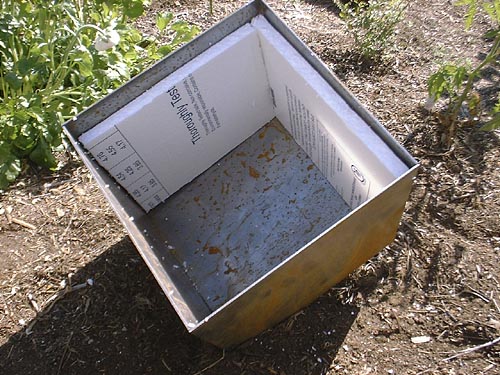Below are instructions on constructing the steel planters I discussed in my last post.
For each planter, you’ll need:
- 5 sheets of 12-guage steel, cut perfectly square (I used pieces 1-foot square)
- disposable welding supplies: either welding wire or steel electrodes
Tools:
- welder
- 90-degree corner clamps (aluminum Pony clamps work well)
- the usual welding protection: welding shield, gloves, sturdy shoes, long sleeves and long pants
Assembly:
- Clamp the sides together in a way that the final bottom piece will be able to slide into the assembly at a slight slant.
- Tack the pieces together using 3 1-inch beads per corner, making sure to leave room for the bottom piece to fit into the planter without running into the welds. Also make sure that two adjacent sides will have their lowest welds a little higher up to be able to accommodate the slanted bottom piece. (You could also use a slightly under-sized bottom panel so you could us it without slanting it, maybe 12 x 11 1/2 or so, depending on how much drainage you want.)
- Slide the bottom piece in at an angle, tilting it a little bit extra to not make the fit too tight, leaving slight gaps for water to drain.
- Tack weld the bottom in several locations.
That’s basically it. It’s a good idea to clean off the oils from the mill using a degreaser or strong detergent. That step will get the rust started. But if you’re anxious to get patina quicker, you can use a weak solution of acid. I used a stop-bath strength dilution of acetic acid from one of my old photo darkroom bottles, but I’ve heard that vinegar (basically acetic acid as well) works just fine as well. Be sure to wear gloves and eye protection, and don’t inhale the nasty fumes! The finish won’t be totally rusty, but it’ll give you a good head start to a nice patina.
A lot of people swear by weak pool acid (aka muriatic or hydrochloric acid), but you’re getting into territory where the materials start to get unnecessarily powerful. You might be in a rush to get more patina faster and think that using strong acid is the way to go. But when the acid gets too strong, it actually removes rust, so staying with something weak and safe is the best way to go. If I haven’t deterred you, though, check out the discussion at Metalgeek for a moderately safe method for the truly impatient.
One little final finesse concerns the use of insulation. Plants in pots often suffer from roots that have to abide wild temperature swings far beyond what they’d experience in the ground. I’ve always felt that metal containers, with their spectacular abilities to transmit heat effectively, potentially could make for some of the most hostile root environments. So I decided to insulate the sides of the pot that would be facing the most intense sun. This heavily canted cube in particular cried out to me for some protection from the extreme heat of the midday rays…and I just happened to have some leftover 1/2 sheet insulation sitting around. So, before I planted the cubes, at least one of the sides got a piece of insulation to moderate the worst of the sun’s heating effects. Here’s a peek inside:
All this is a grand experiment. The insulation may or may not make a difference. I’m sure the cubes will eventually rust out, though hopefully not for ten or more years. In hindsight, priming and painting the interiors might have given the planters a bit more life, but the euphorbias planted in them will eventually outgrow their homes anyway. What in a garden is forever?


